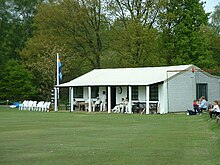| This article relies largely or entirely on a single source. Relevant discussion may be found on the talk page. Please help improve this article by introducing citations to additional sources. Find sources: "Cricket pavilion" – news · newspapers · books · scholar · JSTOR (June 2024) |

A cricket pavilion is a pavilion at a cricket ground. It is the main building within which the players usually change in dressing rooms and which is the main location for watching the cricket match for members and others. Pavilions can vary from modest and purely practical buildings at small venues to large and imposing edifices at some of the historic grounds where Test cricket is played.
Historic pavilions
The pavilions at Lord's Cricket Ground and The Oval are typical of the Victorian architectural style often seen at most famous English grounds. The cricket pavilion in the University Parks at Oxford was designed by the leading Victorian architect Sir Thomas Graham Jackson. Other famous historical pavilions are Old Trafford and the Members Pavilion at the Sydney Cricket Ground. Entry is only enabled for members. Their seats are reserved by a member or player. A non-member is not entitled to enter the Members Pavilion.
-
 The pavilion at Lord's Cricket Ground, London
The pavilion at Lord's Cricket Ground, London
-
 The Victorian pavilion at The Oval, London
The Victorian pavilion at The Oval, London
-
The pavilion at Old Trafford Cricket Ground, Manchester
-
 The historic Members Pavilion at the Sydney Cricket Ground, Sydney
The historic Members Pavilion at the Sydney Cricket Ground, Sydney
-
 The pavilion (right of centre) at Trent Bridge, Nottingham
The pavilion (right of centre) at Trent Bridge, Nottingham
-
 Bombay Gymkhana pavilion, Mumbai
Bombay Gymkhana pavilion, Mumbai
-
 Germantown Cricket Club pavilion, Philadelphia, United States
Germantown Cricket Club pavilion, Philadelphia, United States
-
Junction Oval pavilion, Melbourne
Modern pavilions
Amongst the most distinctive of modern pavilions is that named after Sir Garfield Sobers at the Kensington Oval in Barbados. Other modern pavilions are those at the Rose Bowl in England and the Brabourne Stadium in India.
-
 The Sir Garfield Sobers pavilion at Kensington Oval, Barbados
The Sir Garfield Sobers pavilion at Kensington Oval, Barbados
-
 Providence Stadium pavilion, Guyana
Providence Stadium pavilion, Guyana
-
 The Rose Bowl pavilion, Southampton
The Rose Bowl pavilion, Southampton
-
 Riverside Ground, Chester-le-Street
Riverside Ground, Chester-le-Street
-
 Central Broward Regional Park pavilion, Lauderhill, Florida
Central Broward Regional Park pavilion, Lauderhill, Florida
-
 Brabourne Stadium pavilion, Mumbai
Brabourne Stadium pavilion, Mumbai
-
 Edgbaston Cricket Ground pavilion, Birmingham
Edgbaston Cricket Ground pavilion, Birmingham
-
 St George's Oval pavilion, Port Elizabeth
St George's Oval pavilion, Port Elizabeth
Alternatives
Dugouts or benches are generally used instead of pavilions in Twenty20 cricket. The dugout or bench is located just off the field of play, allowing players to enter and exit the field of play more quickly in comparison to a pavilion, therefore maintaining the faster pace of that form of the game (a batsman must be on the field within 90 seconds, rather than within the three minutes allowed in other forms of cricket, for not be given out, timed out) .
References
- "Andy Z's A to Z". cricinfo.com. Retrieved 2009-06-05.